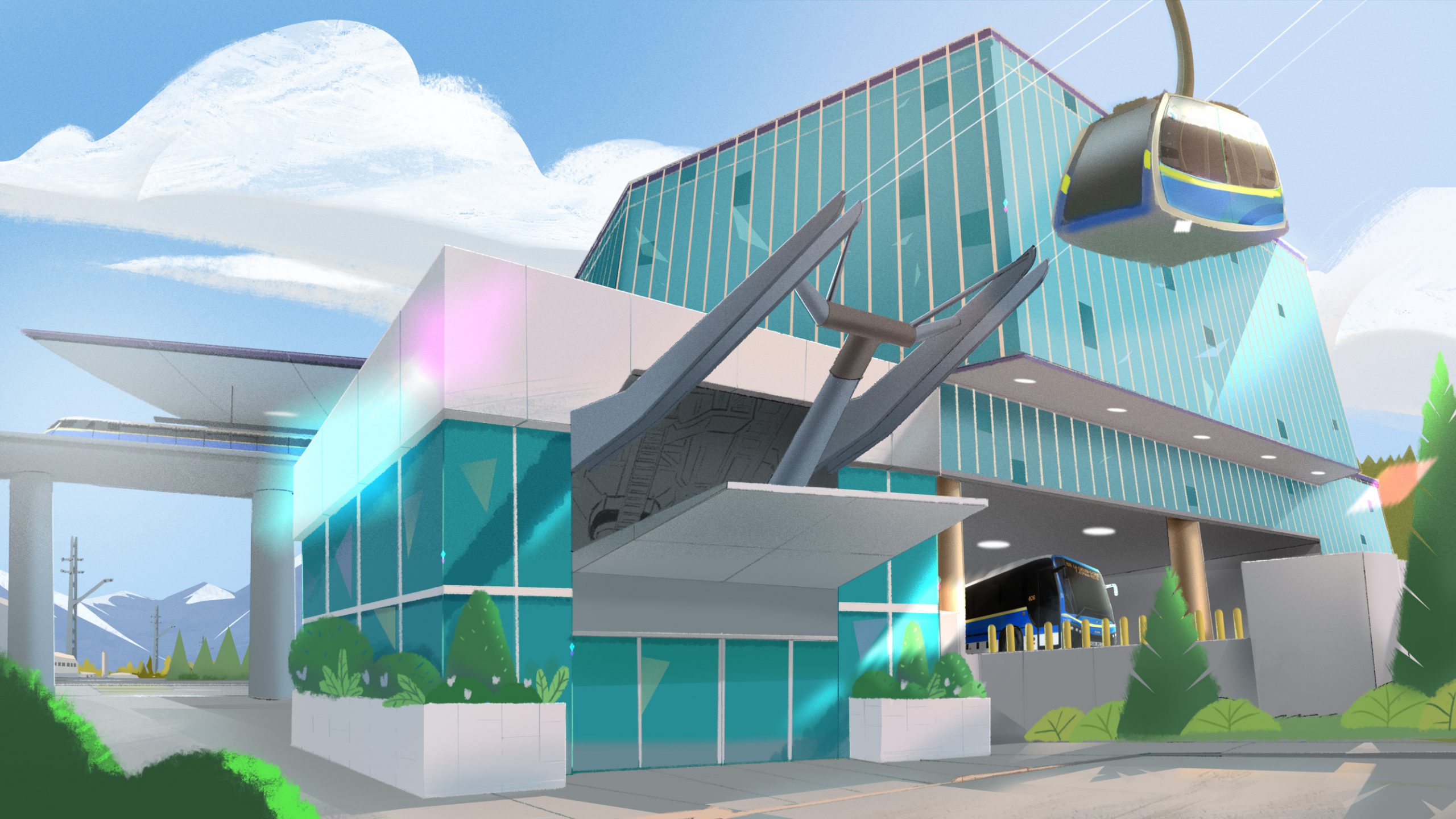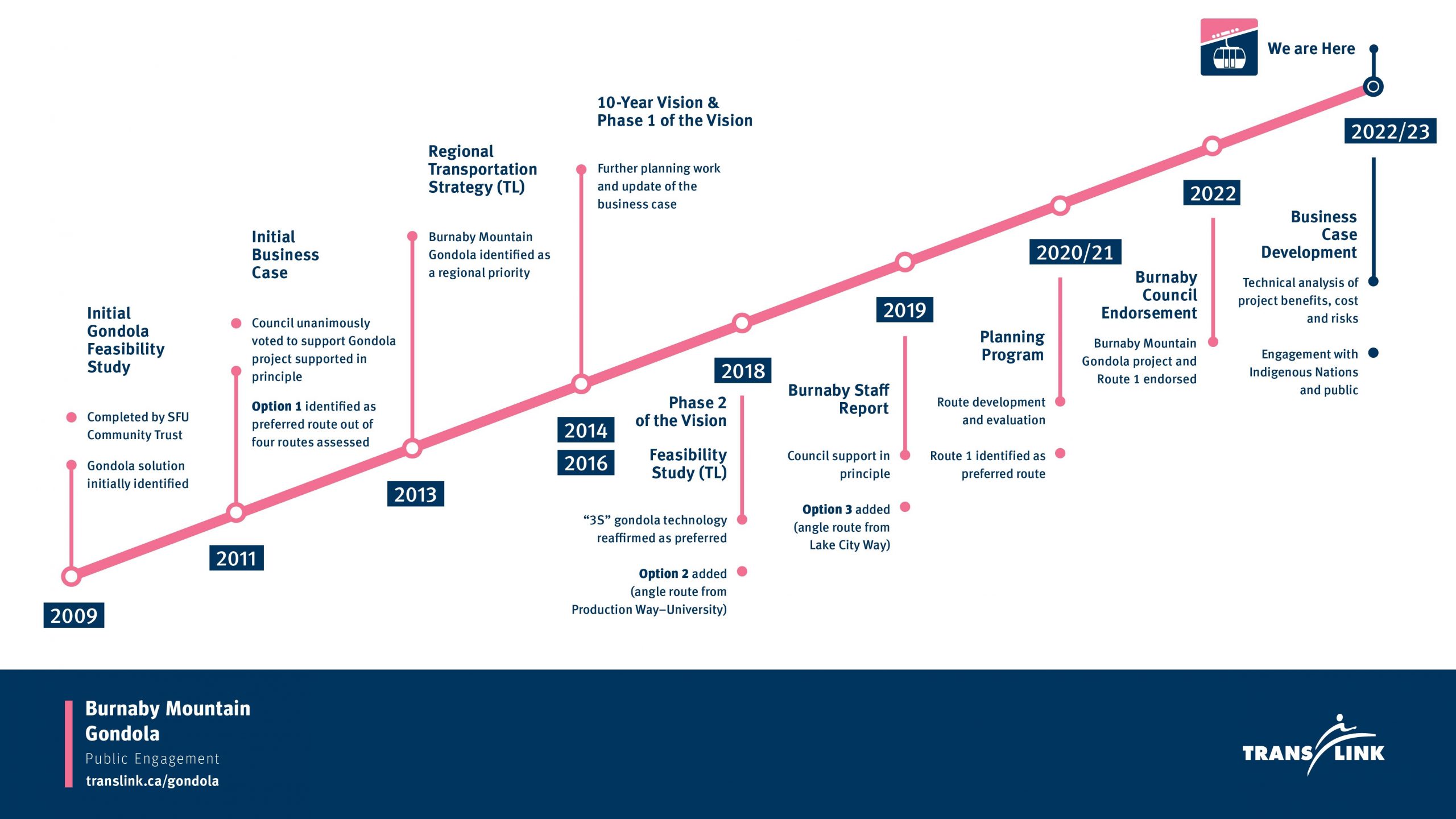What you need to know about the proposed Burnaby Mountain Gondola
What you need to know about the proposed Burnaby Mountain Gondola

The proposed Burnaby Mountain Gondola project recently took a step forward with Burnaby City Council endorsing it. The idea of a gondola connecting SkyTrain to Simon Fraser University has been discussed for over a decade and TransLink has been working behind the scenes to advance its understanding of the project. Let’s look at how the project has evolved and where it stands today.
Project History
In 2014, the Mayors’ Council developed a 10-Year Vision for Metro Vancouver Transit and Transportation which noted that a high-capacity connection from Burnaby Mountain to a nearby SkyTrain station may be required, and that further investigation and consultation was merited.
In November 2016, the Phase One Investment Plan committed to updating a previous 2011 assessment of a gondola linking Production Way–University Station to SFU Square on Burnaby Mountain. This assessment determined that a gondola was a feasible solution for improving travel time, addressing reliability issues, meeting future travel demand, and reducing greenhouse gas emissions.
In 2017, the merits of building a gondola were re-examined and we confirmed that there is still a compelling case for a gondola transit solution.
In May 2019, Burnaby City Council endorsed a recommendation that supports a gondola link from SkyTrain to the top of Burnaby Mountain, subject to several conditions. One condition was to include the assessment of a third route option starting from Lake City Way Station, which has been done as part of the technical work in 2020.
Throughout 2020, TransLink and its partners worked to narrow the three proposed gondola routes down to a single, preferred route. The planning program included work on the conceptual design of the routes, engagement with Indigenous Nations and two rounds of public engagement. The result of the technical work and engagement feedback led to a single, preferred route: Route 1 — the straight route from Production Way–University Station to SFU’s Burnaby campus.
The Burnaby Mountain Gondola Route
This route offers the greatest benefits, lowest costs, and lowest impacts. The endorsed route follows a straight line from Production Way–University Station to SFU’s Burnaby campus with the terminal located near the bus exchange. The route would have a six-minute travel time compared to 15 minutes by bus, with cabins departing about every minute during peak travel times to accommodate the over 30,000 daily trips made by SFU students, staff, faculty and residents. This route also would have the lowest impact on the Burnaby Mountain Conservation Area, with the smallest number of trees removed. The route does cross over a residential community, TransLink is working to mitigate potential project impacts through technical analysis and design.
Gondola technology
The proposed gondola system is a three cable, or 3S system, which operates using three high-strength, multi-strand steel cables. This is the same technology used by the Peak to Peak Gondola at Whistler Blackcomb. Gondola systems are a proven technology with more than 20,000 ropeway systems worldwide. For example, the system in Voss, Norway, has nearly 25,000 trips on an average day, and the system in Koblenz, Germany, has more than 91,000 trips per day. A new 3S gondola system will be opening in 2022 in Toulouse, France that will connect the urban area to a hospital and university campus. Gondola technology is known to be safe and able to operate in all types of weather, compared to the current bus service which can be challenging in winter weather. It can move people up the mountain faster than buses, with improved frequency and reliability, extending our rapid transit network making it a more attractive option to drivers. The gondola will use renewable energy and will also reduce greenhouse gas emissions (GHG) emissions from trips made by bus and vehicles.
Funding and next steps
The proposed gondola project is not yet funded. Capital and operating costs were updated in 2020 and are comparable to the most recent previous study at an estimated $210 million. Council endorsement is a necessary step in advance of further public engagement and to complete the project business case. TransLink can proceed with additional technical analysis to continue to build our project knowledge, and further engage with the public later this year. If the project proceeds, the Mayors’ Council on Regional Transportation would determine if the gondola is a funding priority to be included in a future Investment Plan.
To find out more about more about the proposed Burnaby Mountain Gondola, please visit our project page.







Think big! If not now, at least plan for continuing the gondola north down to the Barnet Highway/WCE/CPR tracks for a new WCE station that could serve SFU, then jump across the water and link up with Admiralty Point park and a redeveloped Ioco site…
More study, business development, and public engagement? With Endorsement from Burnaby Council, how many more “re-affirmations” needs to happen?
Can’t someone make any decision, every study shows the gondola as one of the best value projects in the region, why waste another $100K on more studies?
It hasn’t moved forward because Translinkncant prove anyone actually needs the Gondola.
Their numbers have been exposed as false, and the Gondola has been exposed as a Vanity Piece which is not only a money-pit, but will also destroy sections of a CONSERVATION AREA.
It’s not been approved because the whole project is a farce put on by SFU and Translink because they think it will bring tourism and more students to the school who already has seen an over 60% drop in attendance since the pandemic.
Their business case is over 10 years old and no longer relevant, and they have not done a single environmental study on the area to find out if this project is even possible, and how it will affect wildlife.
They have also not engaged at all with residents who are being threatened and terrorized with the possibility of this project running right over their heads. They just keep talking about “compensation”. There is no compensation for the possibility of a 1000+lb 10ft x 20ft gondola car crashing through the roof of your house and potentially killing your family. Two Gondolas in B C have hit the ground multiple times and no one can assure anyone this one wont fall on residents.
These are just a few reasons why this project is not what it is being sold to the public as.
Go cry somewhere else.
Nobody cares about the handful of co-op people that will be effected by this….
Greater good
Since 2009……… really……enough s… or get off the pot…….
Please build this system, it is really the missing part of the mobility solution for burnaby.
This needs to get built now. Shovels at the ready! Aside from a few townhouse dwellers on Burnaby Mountain there is huge support for this.
Started from 2009. Now it’s 2023. still in Technical analysis of …… Is this web telling jokes.